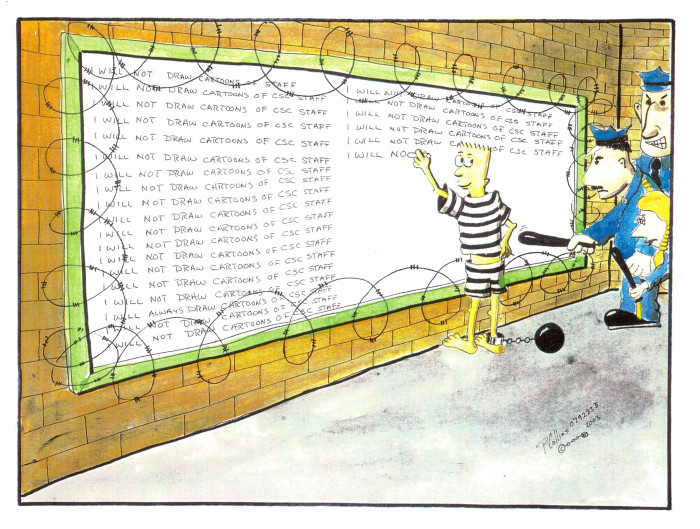Book Review: Free Inside: The Life and Work of Peter Collins
 Peter Collins
Peter CollinsMany Canadians today may rest easy thinking our justice system tirelessly ensures that criminals serve their sentences with their dignity and well-being intact. However, the work of the late Peter Collins, a former inmate at the Millhaven Institution in Bath, Ontario, reveals the Corrections Service Canada’s (CSC) history of systemic injustice and corruption.
Free Inside: The Life and Work of Peter Collins is a collection of essays, political cartoons, and artwork Collins created during his incarceration. As a young adult, Collins was convicted of killing a police officer. Imprisoned for the next 32 years at Millhaven, he later became a prolific artist, political cartoonist, and social activist. While initially diagnosed with a treatable form of kidney cancer, a negligent prison bureaucracy ensured Collins’ cancer was terminal. He finally died on August 18, 2015, aged 53.
Collins’ thoughtfully considered essays directly contend with his experiences of the CSC’s belligerent, discriminatory, and abusive actions, offering insight into how prisons can delegitimize and dehumanize their occupants. Drawing on his traumatic upbringing, Collins argues that incarceration should operate not merely as draconian punishment, but as a restorative and empathetic endeavour to truly rehabilitate criminals into people again.
His political cartoons are equally worth their salt, showcasing the CSC’s frequent hypocrisy and Catch-22s. While primarily devoted to revealing the inadequacies of the Canadian prison system, Collins also features critiques of other topics, including the Conservative Party, the Albertan oil sands, and the War on Terror. Despite wardens’ and Crown psychiatrists’ criticisms of Collins as “anti-authority” and “anti-CSC,” his messages are always that of accountability and respect, urging both himself and his jailers to “be better.”
However, Collins’ artwork strikes the greatest cord. His work sometimes features horrifying imagery, such as abstract gash wounds, barbwire hypo needles, and bloodshot eyes, and his cartoons aptly showcase the often brutal atmosphere of prison life. However, Collins’ strongest artwork highlights his recurring motif of birds and owls perched upon barbwire. As compared to the gruesome imagery of crushed prisoners and gouged-out eyes, these pieces are much quieter, expressing hope for freedom to overcome the suffocation of prison.
Ultimately, Free Inside offers unique and powerful insights into the significant injustices of the Canadian prison system and the concentrated efforts of one man to rectify them. Through his posthumous works, Peter Collins is a compassionate and thoughtful man, admitting responsibility for his past actions and always persevering to improve his own life and those of his fellow Canadian prisoners — to allow them to be free inside.
“A caged man is a spirit trapped in steel — leave him alone and his spirit comes one with his cage — it’s all he knows,” Collins writes on page 149 of Free Inside. “Motivate him, nurture and socialize him, and his spirit soars. It’s only then that the man realizes the difference between him and his cage — the reasons for it. Thus, allowing him to finally be free of it.”




